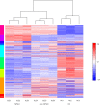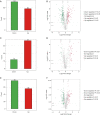Comparative proteomics analysis of plasma protein in patients with neuropsychiatric systemic lupus erythematosus
- PMID: 32566606
- PMCID: PMC7290550
- DOI: 10.21037/atm.2020.04.58
Comparative proteomics analysis of plasma protein in patients with neuropsychiatric systemic lupus erythematosus
Abstract
Background: The aim of this study was to evaluate serum biomarkers of systemic lupus erythematous (SLE) patients, with and without neuropsychiatric (NP) manifestation by high-resolution proteomic analysis.
Methods: SLE patients with NP (NPSLE, n=9), SLE patients without NP (non-NPSLE, n=9) and healthy controls (HC, n=9) were prospectively enrolled in this study, and their plasma samples were collected and pooled into 3 NPSLE, 3 non-NPSLE and 3 HC samples for discovery profile. The TMT-LC-MS/MS-based proteomics approach was used to identify the differential proteome among the three matched groups, and the data were analyzed by bioinformatics tools, including Gene Ontology (GO) categories, Kyoto Encyclopedia of Genes and Genomes enrichment analysis, to explore canonical pathways and networks involved in the pathogenesis of NPSLE. To validation of differentially expressed proteomics results, four proteins were measured by ELISA.
Results: There were altogether 223 differentially expressed proteins in NPSLE groups compared with healthy controls (HC), of which 96 proteins increased while 127 proteins decreased. Compared with non-NPSLE, there were only 49 differentially expressed proteins in NPSLE groups, of which 37 proteins increased while 12 proteins decreased. The significantly changed pathway that those proteins are involved in was complement and coagulation cascades in NPSLE group compared with health controls. However, we didn't find significantly changed pathway between NPSLE group and non-NPSLE group. Five proteins were found significantly changed in all group-comparisons with consistent tendencies using Venn analysis, including Vitamin D binding protein (VDBP), C-reactive protein (CRP), KRT16, IGHV4-4 and CTRP3. Four proteins including CTRP3, VDBP, PAPPA and TRYP2 were selected to estimate the validity of the proteomics approach by ELISA. The expression levels of CTRP3 and TRYP2 were significantly changed in NPSLE patients compared with either HC or non-NPSLE patients.
Conclusions: Our research has successfully established serum protein profiles of NPSLE and non-NPSLE patients through TMT technology and screened out five proteins significantly changed in group-comparisons with consistent tendencies. The pathway of complement and coagulation cascades may participate in pathogenesis of NPSLE and non-NPSLE.
Keywords: Neuropsychiatric systemic lupus erythematosus (NPSLE); gene ontology (GO) terms; kyoto encyclopedia of genes and genomes; proteomics analysis.
2020 Annals of Translational Medicine. All rights reserved.
Conflict of interest statement
Conflicts of Interest: All authors have completed the ICMJE uniform disclosure form (available at http://dx.doi.org/10.21037/atm.2020.04.58). The authors have no conflicts of interest to declare.
Figures









References
LinkOut - more resources
Full Text Sources
Research Materials
Miscellaneous
